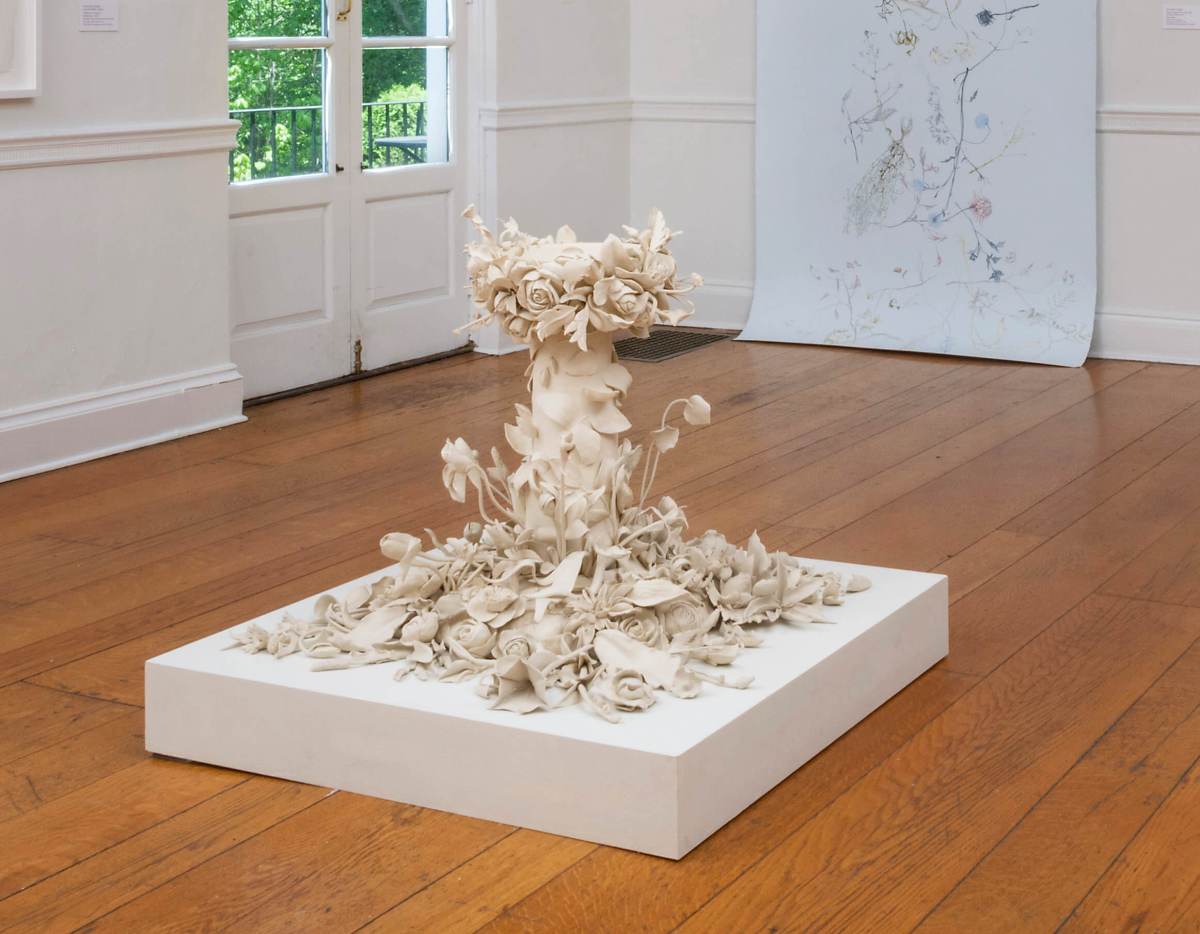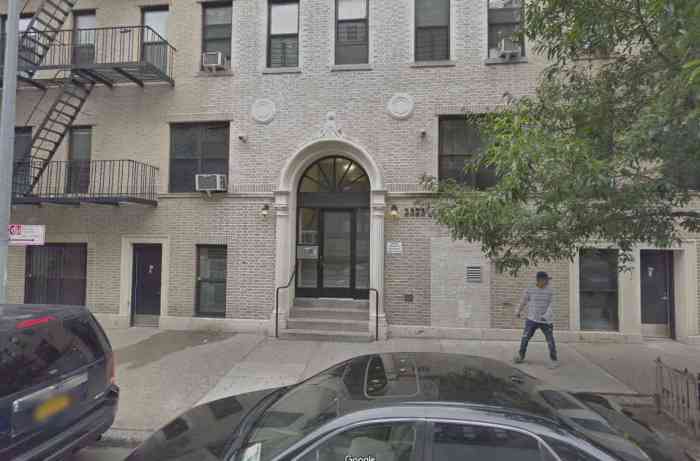In 2012, the Canadian artist Zachari Logan, who is tall and has tattoos on both arms, was curating a group show, “Passages,” at the Daniel Cooney Gallery in New York. One day, Logan pressed the wrong button in the elevator of the building the gallery was in, only to make an inspiring discovery.
“I came out of the elevator and I saw, ‘Ross Bleckner Studio’ and I just thought to myself, ‘Hmm…,’” he said during a recent conversation with Bleckner and curators of “The Shadow of the Sun,” a serenely beautiful exhibition pairing the two artists, on show at the Glyndor Gallery at Wave Hill in the Bronx from May 22 to August 15.
Bleckner, the American abstract painter whose rise to prominence began in the 1980s with works reflecting on the AIDS crisis, had been an influence on Logan since Logan’s art-school days in Saskatchewan, Canada’s centermost Prairie, or Midwest, province.
Logan invited Bleckner to participate in the group show he was organizing, and Bleckner, long intrigued by the place Logan was coming from, accepted.
“Something about the whole Saskatchewan thing always fascinated me,” Bleckner said. “My love of the idea of dramatic landscape.”
Thus began a series of collaborations between the two artists, the latest of which is “Shadow of the Sun,” a conversation the curators describe as “the omnipresence of life and death through notions of loss, decay, visibility/invisibility, memory, flora, and landscape.”
Notably, Bleckner and Logan’s conversation is one being had between two gay-identified artists across careers, borders, influences, generations, genres, and materialities, producing a shared sensibility and harmonious voice.
“Shadow of the Sun” features both collaborative and individual works of drawing, painting, and sculpture, most with a floral motif. There is also a “site-specific” drawing of an arc of flowers and weeds Logan sketched directly onto one wall that creeps from one side of the gallery to the other. Symbolic of the intersecting of the artists’ practices, the arc leads to a point on the wall where a Bleckner painting is hung, a pot of gold at the end of the rainbow.
“When we discussed and decided we would work on collaborations, the next conversation, I think, was [about what] materials [to use],” Logan said. “And, I had mentioned paper. Ross said he didn’t really work on paper and then we excavated his files and found hundreds of incredible works on paper.”
They selected a series Bleckner had created using obituaries from the New York Times. “Since I’m a teenager, I liked reading the obituaries,” Bleckner said. “I like using them in the Buddhist sense: that the reflection and acknowledgement of dying makes your life have more meaning every day.”
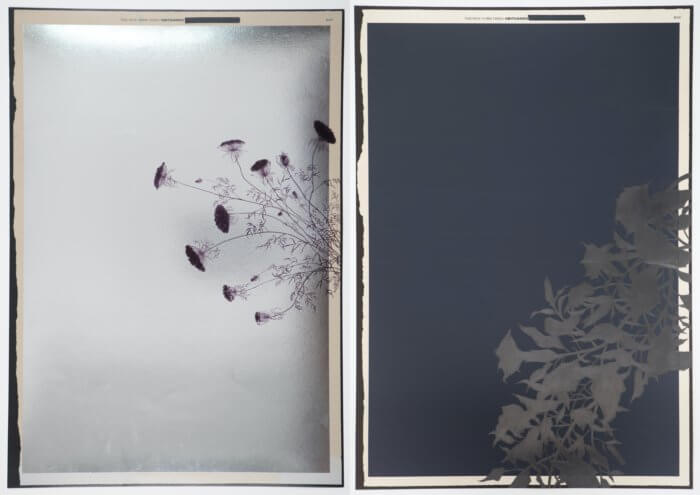
On one of the pieces, Bleckner overlaid the full broadsheet of one obituary with reflective mylar, “so that when you’re looking at the print, you’re actually looking at yourself,” he said, and on another it is totally black, meaning that to every life there is an end but that end is unforeseeable.
Another in the series was meant as a personal tribute from Bleckner to the subject, Dr. Donald M. Kaplan, a psychoanalyst who taught at NYU whom Bleckner regards as having been “a wonderful teacher to me.”
These works were transported to Logan’s studio in the city of Regina, Saskatchewan, where he drew weeds and abstract shapes on them.
“You could say Zachari brought the obituaries back to life,” Bleckner said.
The title of the exhibition is an homage to the book of the same name by Polish journalist Ryszard Kapuściński (1932-2007). The book’s contents — the writer’s travels as a foreign correspondent around the continent of Africa — and its cover image, a photograph of the back of a weary ferryman at the bow of a canoe as it reaches an arid shore, by French photographer Françoise Huguier, intrigued Wayne Baerwaldt, one of the show’s co-curators. “There is no shadow here,” he said. “The sun in coming straight down…I was interested in this title as something of a paradox” about luminosity.
The notion fit with Bleckner’s work. “A lot of times I’ll start paintings by painting them black and then trying to find their way out into light,” he said. One of the strongest examples of this process is his oil-on-paper painting Untitled (2008), which is luminous flowers against a black background that is baffling to the eye. In creating it, Bleckner said, “I was able to go back into the light from the dark, which is something I like to do.”
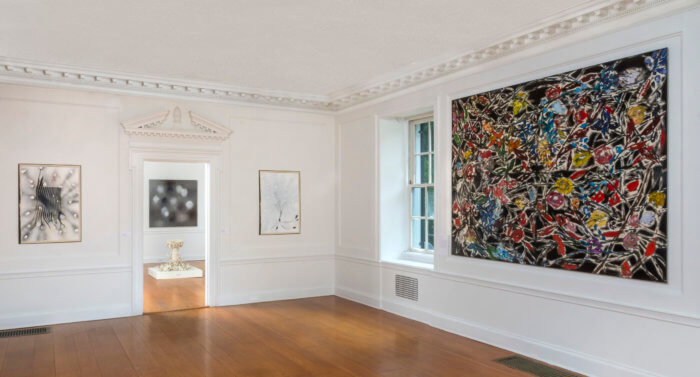
The centerpiece in one of the exhibition rooms is Logan’s sculpture, Fountain 1 (2013). It is a ceramic pedestal crowned and skirted by overgrown tangles of flowers, leaves and tendrils. The work looks simultaneously commemorative and forgotten, a man-made imposition on the land onto which the land has reimposed itself. Logan left the clay unpainted because, he says, the material is “the color of bones.” Added to the sculpture’s color, its brittle, unglazed form has to be repaired and recomposed every time the piece is shown, further reminiscent of ossification.
“It comes right back to implications of my body in the place where I live,” Logan said. “How I’m affected by it and it is affected by me.” He is referring, he says, to the presence of his own body as a settler on Native land, Saskatchewan, and the bones reminiscent of the now extinct buffalo whose slaughter was integral to settler colonialism. “My body is always a catalyst for my work regardless of whether or not it’s a depiction of myself,” he said.
“It absolutely does have this sense of the memorial or commemorative to it,” said Baerwaldt. “The Canadian government was out to eradicate the buffalo – the main source of food for Native peoples…to starve [Natives] off the Prairies. So, I think in this idea of using bone-colored flowers as a tribute, a sad commemoration, has another set of roots.”
Logan was also inspired by a 2009 visit he and husband Ned paid to the gay icon Oscar Wilde’s tomb in Père Lachaise Cemetery, in Paris. Approaching it from a distance, Logan noticed the blanket of red lipstick marks covering much of the exterior and initially thought it was moss. Only upon closer inspection did he realize it was the work of Wilde enthusiasts participating in a ritual to, for some admire Wilde’s queerness, for others admonish his misogyny.
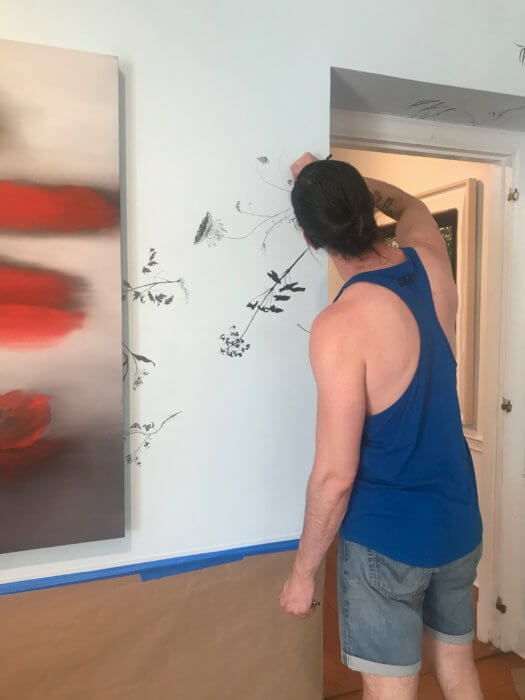
“For me, it was like this inflaming of this tomb,” Logan said. “All these people coming together and, sort of, changing this monument, one kiss at a time.”
Much of the collaboration between Bleckner and Logan pertains to space and place, in reaching and teaching one another’s geography by speaking through a language of flora.
“A lot of my work has to do with putting things on and taking things away,” said Bleckner. “What’s left is not-a-flower. It was something, but now, now it’s just a mark, a painted mark. So, it’s like a memory of a flower. You know, after they’re gone, that’s what’s left.”
Nicholas Boston, Ph.D., is an associate professor of media studies at Lehman College of the City University of New York (CUNY), and author of “The Amorous Migrant: Race, Relationships and Resettlement” (Temple University Press).

